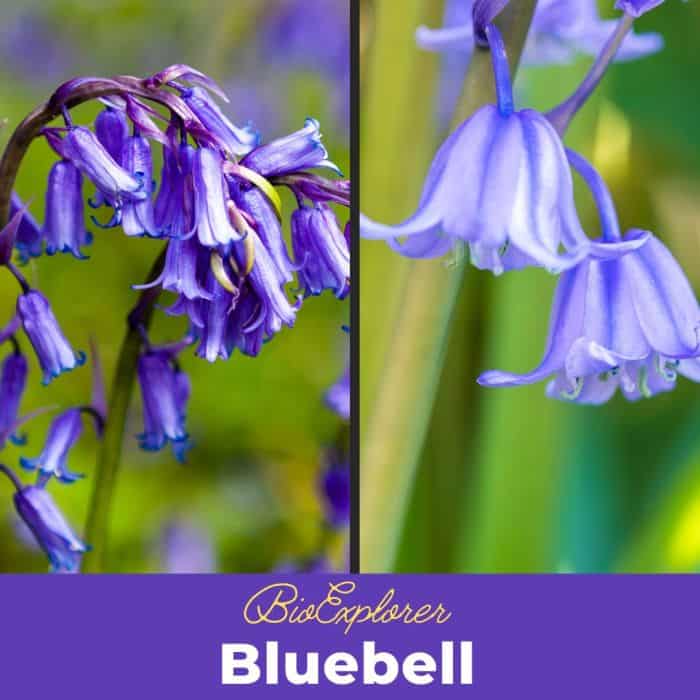
Picture yourself walking through an ancient, wild wood, the earth carpeted in a perfumed ocean of violet-blue petals. The Bluebell flower (Hyacinthoides non-scripta) brings this magical scene to life.
The Bluebell is not only a flower that looks nice, but holds symbolic meaning of spring and play a crucial role in the woodland ecosystem. Bluebells, they make their appearance in forested regions between March and June, blooming in the spring transforming into carpets in the forests of very aesthetic and romantic Atlantic regions of the most captivating areas ranging north-western from the Iberian Peninsula to the British Isles.
Under their canopies, they also form hanging, one-sided racemes of tubular, sweet-smelling purple-blue blossoms, giving rise to a marvelous sight that has wowed plant enthusiasts since ancient times.
So, without further ado, let’s explore the wonderful world of the Bluebell flower in this in-depth Bluebell guide, including their botanical characteristics, ecological significance, different colors of bluebells, various types of bluebells, fun facts and more.
Table of Contents
Botanical Characteristics
| Plantae | Magnoliopsida | Asparagales | Asparagaceae | Hyacinthoides non-scripta |
- Plant Type: Perennial
- Common Names: Bluebell, Common Bluebell, English Bluebell, British Bluebell, Wild Hyacinth, Wood Bell, Fairy Flower, Bell Bottle.
- Flower Dimensions: 14 to 20 millimeters long.
- Flowering Season: Spring
- Flower Colors: Violet-blue (rarely white or pink).
Taxonomy and Nomenclature
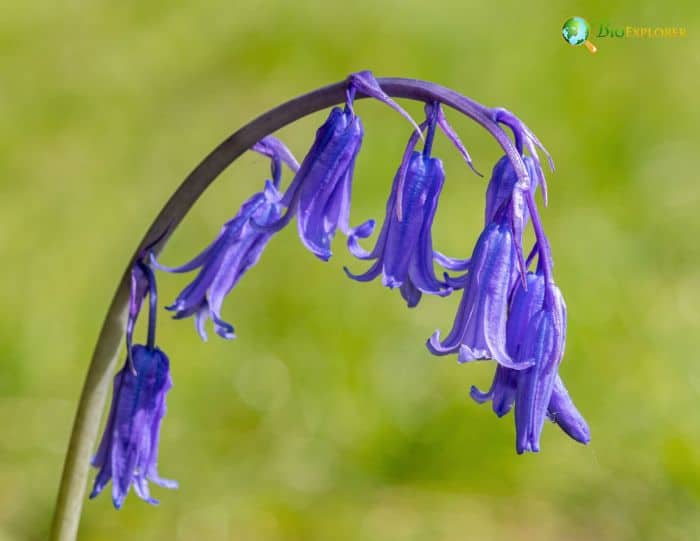
Bluebell is the common name for the Hyacinthoides non-scripta, a well-known ornamental bulbous perennial plant of the Asparagaceae family in the subfamily Scilloideae. It was originally described by Carl Linnaeus in 1753 as a species of Hyacinthus in his work Species Plantarum.
The name Hyacinthoides var. non-scripta means “like a hyacinth” but specifically one that is “unlettered” or “enciphered“, distinguishing it from the hyacinth of Greek myth that bears a marking at the flower base.
Since then, the Bluebell has been re-listed and reclassified on a few occasions. It was formerly placed in the genus Scilla and later in the genus Endymion. The species was moved into the genus Hyacinthoides in 1934 by Pierre Chouard.
Physical Description
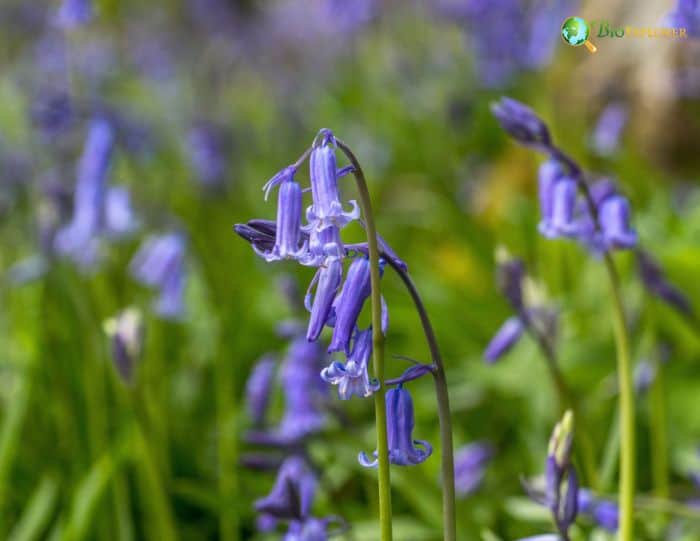
Hyacinthoides non-scripta is a perennial plant that grows from a bulb. It can only grow linear leaves and grows 3-6 linear leaves at the base 7-16 mm width each. It has 5 to 12 (rarely 3 to 32) flowers in stem up to 500 mm tall drooping towards the tip, giving it an appearance of “nodding“.
The racemes are unilateral and 14–20 mm long, possessing paired bracts at the base of their flowers. The six tepals are strongly recurved at their tips and are violet-blue in color. The outer 3 stamens are fused to the perianth for more than 75% of their length and bear cream-colored pollen. Beside being conspicuous to look at they exude a powerful sugary sweetness that lures pollinators.
Side by side the differences between H. non-scripta and H. hispanica (Spanish Bluebell) can be summarized as follows:
- H. non-scripta has darker flowers borne in one-sided, nodding racemes with strongly recurved petals and white pollen.
- H. hispanica features paler flowers produced on all sides of the upright stem, with less recurved petals and blue pollen.
Lifecycle and Reproduction
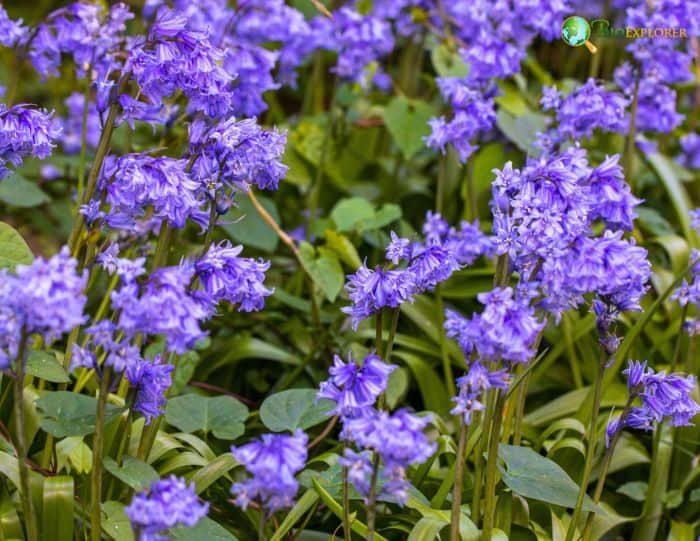
The life cycle of Hyacinthoides non-scripta starts with seed germination, a process that requires some environmental temperatures. To allow for embryo growth and germination, researchers have found a sequence of high summer temperatures followed by cooler autumn and winter temperatures is needed. Emergence is delayed, following radicle emergence, and the seedlings grow slowly once germinated.
They are visited by many different types of Insects but are primarily pollinated by bumblebees. Reproduction is by seed and vegetatively by bulb offsets, resulting in dense aggregates capable of smothering out other plant growth in woodland understories.
Bluebell bulbs have contractile roots, which means they contract to pull the bulb deeper into the soil to reach water. This adaptation allows for the Plants to survive in different types of soil conditions and their success in woodland environments.
| Flower Arrangement | One-sided, nodding racemes | Radial, upright racemes |
| Petal Recurrence | Strongly recurved | Less recurved |
| Flower Color | Dark violet-blue | Paler blue |
| Pollen Color | Cream | Blue |
| Scent | Strong and sweet | Faintly scented |
![]()
Habitat and Distribution
Geographic Range
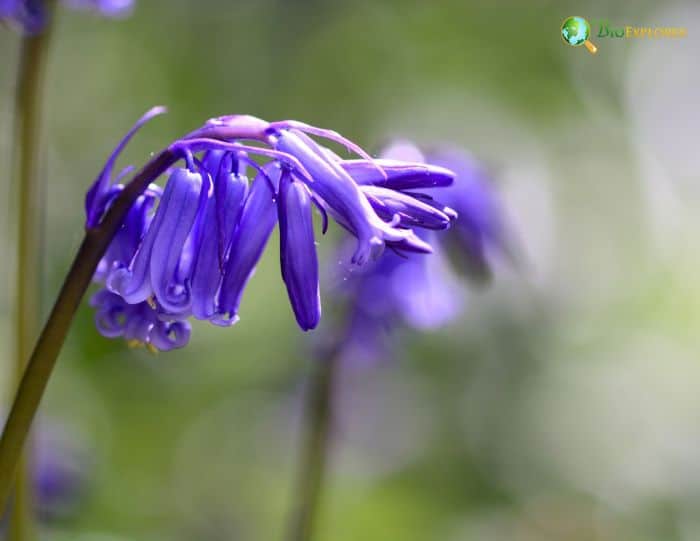
Hyacinthoides non-scripta, the bluebell, is native to the western part of Atlantic Europe from north-western Spain to the British Isles. This distribution reflects its preference for the temperate climates and particular ecological conditions most abundant in the above regions.
Bluebell native range the Bluebell is now found as an introduced species in many regions, and has been reported in the wild in parts of such diverse places as Scandinavia, Australia, and Spain.
These areas are wide-ranging (some parts of North America, mainly the Pacific Northwest, including BC, WA, OR; some parts of the Great Lakes region, including ON, NY, OH, PA; other parts of the US, including the Virginias, KY, IN). It is also naturalized in New Zealand. Growing in places similar to those of its natural habitat, in some of those regions the Bluebell became an invasive plant.
| British Isles | Pryor’s Wood, Ashridge Estate, Hampshire | Ancient Woodlands |
| Northwestern Spain | Forested and coastal areas | Forests and Meadows |
| Northwestern Portugal | Coastal and forested regions | Coastal Meadows |
| Pacific Northwest (USA) | British Columbia, Washington, Oregon | Gardens and Wild Areas |
| Great Lakes Region (USA/Canada) | Ontario, New York, Ohio, Pennsylvania | Gardens and Wild Areas |
| Other States (USA) | The Virginias, Kentucky, Indiana | Gardens |
| New Zealand | Various regions | Gardens and Meadows |
![]()
Preferred Habitats
Bluebells are often a sign of ancient woodlands, as well as being known to create violet-blue carpets in forests during the spring months. This environment is perfect for Bluebells, with the right type of soil and a canopy that protects them.
- Bluebells enjoy a soil condition that is slightly acidic.
- Well-suited to soils high in organic matter such that found in ancient woodland beds.
- The presence of AMF (Arbuscular mycorrhizal Fungi) in the roots of plants confers the ability to take up parasitically acquired phosphorus into the host system and helps the plant in growth.
Ecological Role
- Indicator Species: Bluebells are an indicator species of ancient woodland. Their presence is an indication of years of a stable ecosystem gone unchanged.
- Pollinators: Bluebell and other related species have rich pollen and nectar producing flowers, which lures whole host of pollinating insects with bumblebees predominating.
- Fungal Interations: The bluebell is host to the parasitic Uromyces muscari which causes bluebell rust. This interaction is part of the complex web of relationships within their ecosystems.
Seasonal Patterns
- Bluebells bloom in spring, getting in at the start of the growing season before the woodland canopy closes. This enables them to take the greatest advantage of light availability for Photosynthesis and growth.
- The climate can have a bearing on the flowering period. Earlier flowering due to warmer winters and springs might disrupt synchrony with pollinator activity.
Colors of Bluebells
Hyacinthoides non-scripta is commonly called the Common Bluebell and is well-known for its vivid Violet-Blue Flowers. The dense, nodding clusters of these flowers create a striking contrast against the surrounding green foliage of ancient woodlands and other natural habitats.
Flower Color Variations
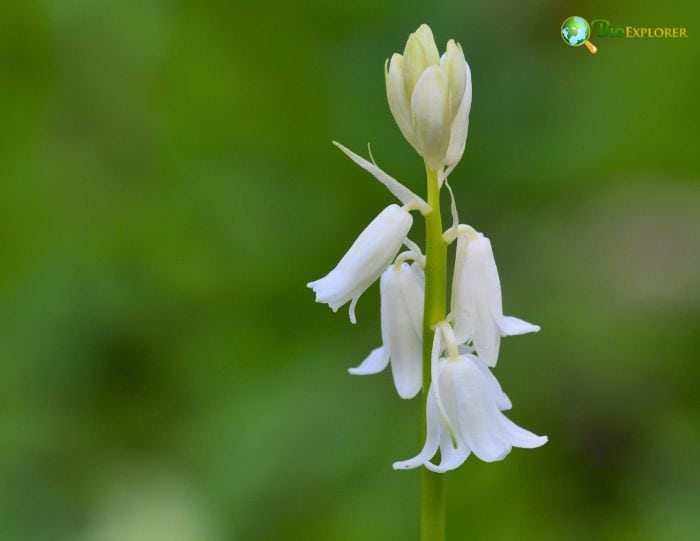
Although Bluebell Flowers are predominantly the color violet-blue, shades can vary depending upon habitat or region, and local gene pool. Below are some features that describe these variances:
- Classic Violet-Blue: This is the most common color of the flowers of the common Bluebells. They are attractive to pollinators, such as bumblebees, especially in this bright color.
- Lighter Blue: Every now and then, Bluebell flowers will grow in a paler blue hue. These differences sometimes mimic the neighboring Hyacinthoides hispanica though that species generally has a paler color flower.
- White and Pink: Bluebell flowers are not white or pink in color, but some Bluebells out there can grow a pink or white bloom rare as it may be. These color variations are due to Genetic Mutations and are not commonly found in wild populations.
Comparison with Related Species
The color of Bluebell flowers is one of the key distinguishing features from related species, particularly Hyacinthoides hispanica (Spanish Bluebell). The table below summarizes the differences:
| Flower Color | Deep violet-blue | Paler blue |
| Pollen Color | Cream | Blue |
| Scent | Strong and sweet | Faintly scented |
| Flower Arrangement | One-sided, nodding racemes | Radial, upright racemes |
| Tepal Recurrence | Strongly recurved | Less recurved |
![]()
These color differences not only help in identifying the species but also play a role in their ecological interactions, particularly in attracting specific pollinators.
Ecological Significance of Flower Color
The neon violet-blue hues of Bluebell flowers are an essential part of their lifecycle. This coloration has a number of ecological advantages:
- Luring Pollinators: Bumblebees, the key pollinators of Bluebells, are highly drawn to this bright shade. Both these organisms benefit each other, where the flower is successfully pollinated and plant generates seed.
- Camouflage and Protection: Despite sticking out in woodlands due to their bright coloration, the flowers can be camouflaged among the transformation and defense of animals that they offer protection from herbivores.
- Signal of Health: Healthy Bluebell populations (with shiny vibrant colors) are the sign of healthy functioning ecosystem. On the flip side, differences in flower color can even indicate environmental stress or genetic defects within the population.
Types of Bluebells
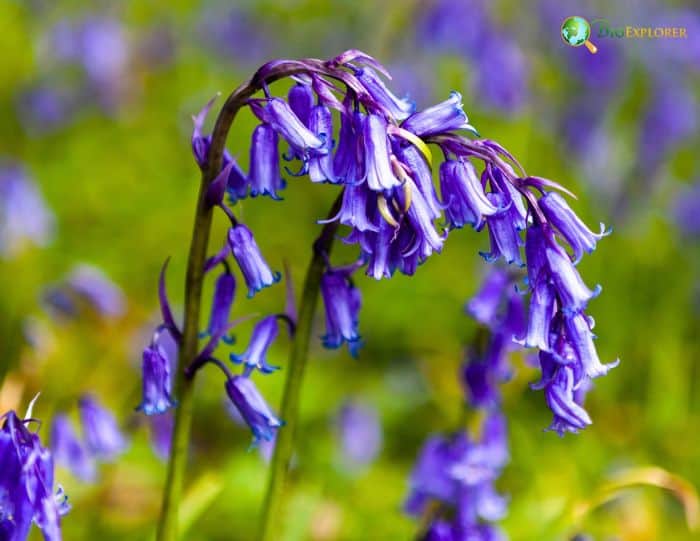
One of the most familiar spring flowers in the UK, grows in woodlands throughout the UK, the common Bluebell, is the best-known species in its genus. However, it is closely related to other species and hybrids that share similar characteristics. Understanding the different types of Bluebells and their hybrids can provide valuable insights into their biology and conservation
Common Bluebell
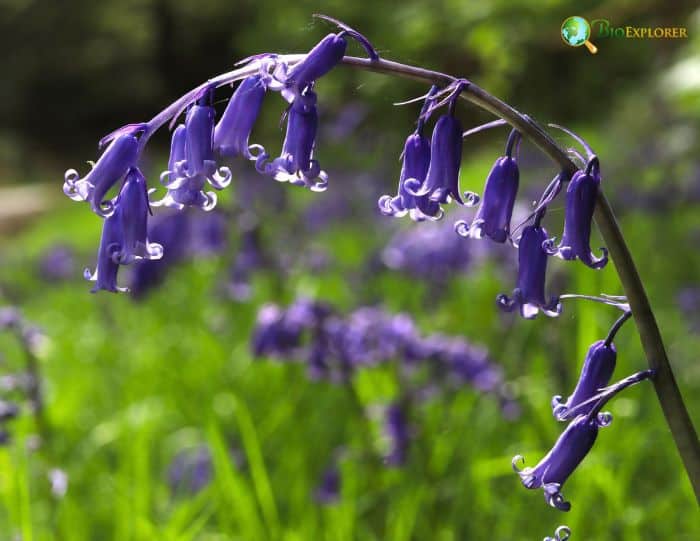
The common Bluebell is characterized by its deep violet-blue, nodding flowers arranged in one-sided racemes. It has strongly recurved tepals and cream-colored pollen. The flowers have a heavy, sweet fragrance.
These are primarily found in ancient woodlands, coastal meadows, hedgerows; throughout British Isles, northwestern Spain, and Portugal.
Spanish Bluebell
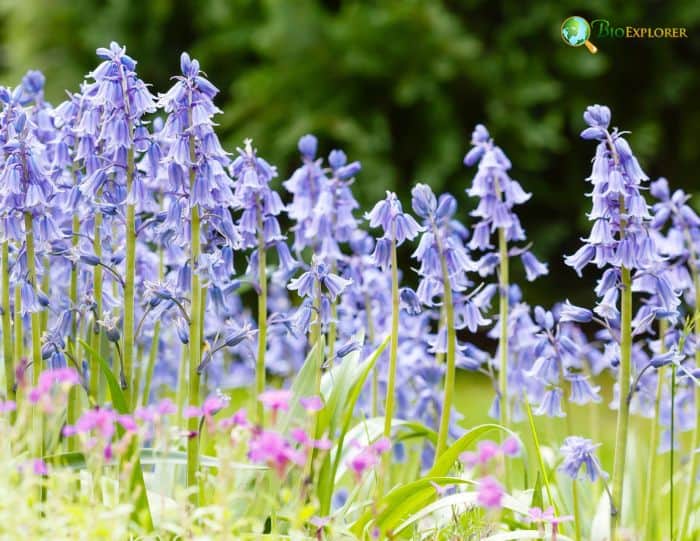
The Spanish Bluebell has flowers that are paler blue and arranged in a radial path around the stem. Tepals are more upright, not as strongly recurved as flowers with a scent; scent sometimes barely perceptible. It has blue pollen which is a distinguishing feature from the common Bluebell.
These Spanish flowers thrive in the Iberian Peninsula, it has been introduced to Great Britain and Ireland, where it is known in cultivation and locally naturalized in the wild.
Hybrid Bluebell
These are crossbreed species between H. non-scripta and H. hispanica. The hybrid exhibits intermediate characteristics, such as flowers with varying shades of blue, less recurved tepals, and different degrees of scent strength. The pollen color can vary between cream and blue.
Hybrids are common in habitats where the ranges of the parent species overlap, especially gardens and woodland edges in the British Isles.
Other Related Species
- Hyacinthoides paivae: A narrow endemic, from north-western Iberia (Galicia and neighboring parts of Portugal). It has mostly the same features as H. non-scripta, however it is separated from it geographically.
- Hyacinthoides cedretorum: Known only from the mountains of western North Africa (Morocco and Algeria). These flowering species adapted to drier conditions than its relatives.
| Flower Color | Deep violet-blue | Paler blue | Variable shades of blue | Violet-blue | Violet-blue |
| Pollen Color | Cream | Blue | Cream or blue | Cream | Cream |
| Scent | Strong and sweet | Faint | Variable | Sweet | Sweet |
| Flower Arrangement | One-sided, nodding racemes | Radial, upright racemes | Intermediate | Nodding racemes | Nodding racemes |
| Tepal Recurrence | Strongly recurved | Less recurved | Intermediate | Strongly recurved | Strongly recurved |
| Habitat | Woodlands, meadows | Gardens, wild | Gardens, woodland edges | Iberian Peninsula | North African mountains |
![]()
Understanding the different types of Bluebells and their hybrids is crucial for their conservation and for appreciating the diversity within this beautiful genus.
Fun Facts of Bluebells
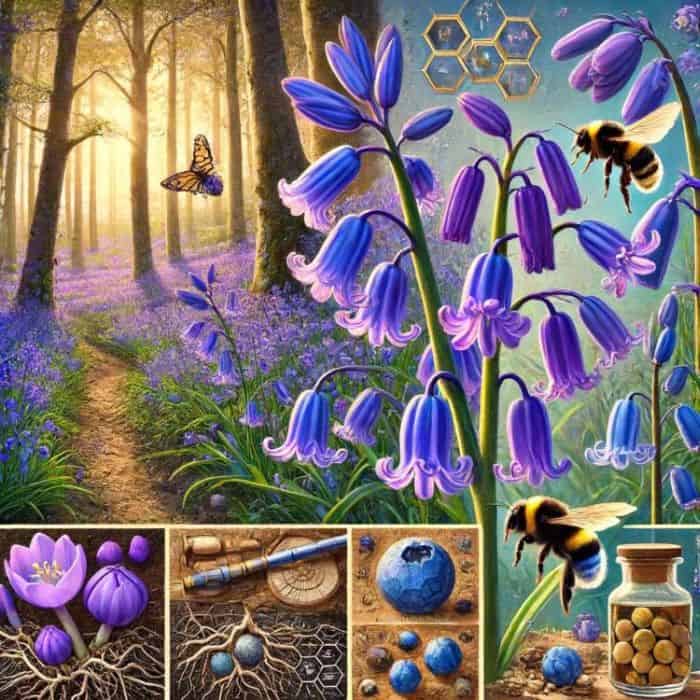
- Smell Sweet for Pollinators: Bluebells are sweetly scented, attractive to bumblebees which feed on the nectar and transfer pollen between other plants of the same species. This scent is important for attracting pollinators and eventually helping to produce seeds.
- Indicator of Ancient Woodland: Bluebells are frequently used as an indicator species for discovering ancient woodlands. The presence of these indicates that the woodland has formed over a long-time scale, usually hundreds of years.
- Bluebell Woods: The UK and Ireland are famous for their spectacular Bluebell woods. These areas are thought to contain between 25% and 50% of all common Bluebells that creates spectacular displays in late spring.
- Contractile Root: The contractile roots of Bluebell bulbs, pull them down to moisture in the soil. This adaptation makes it easier for the plants to survive in different kinds of soil and to be persistent despite the tough environments.
- Genetic Purity Concerns: Hybridization with the Spanish Bluebell (Hyacinthoides hispanica) can lead to genetic dilution of the native Bluebell populations. Hybrids, known as Hyacinthoides × massartiana, exhibit intermediate traits and can outcompete native Bluebells.
- Cultural and Mythological Significance: The name Hyacinthoides non-scripta means “unlettered” or “unmarked”, distinguishing it from the mythical hyacinth of Greek mythology. According to legend, the hyacinth flower sprang from the blood of the dying prince Hyacinthus, with the god Apollo marking its petals with his tears.
- Reproduction and Spread: Bluebells reproduce by seed as well as vegetatively by means of bulb offsets. This dual way of reproducing allows them to spread quite easily and outcompete for dominance of the woodland understories.
- Climate Influences Flowering: Its flowering period can depend on the state of climate. Winters and springs getting warmer can prompt earlier blooming, a possible disruption in synchronization with pollinator activity.
- Medicinal Properties: Bluebells are rich in biologically active compounds that have medicinal properties. Certain extracts, such as water-soluble pyrrolidine alkaloids, are similar to compounds tested for use in combating HIV and cancer.
- Legal Protection in the UK: In UK, Bluebells are covered by the Wildlife and Countryside Act 1981. Bluebells are protected by law in the UK and as such it is not only illegal to take them from the wild for commercial purposes, this can face fines of up to £5,000 per bulb for illegal trade.
These fascinating facts highlight the ecological, cultural, and biological significance of Bluebells, making them a cherished and important part of our natural heritage.
Conclusion
The Bluebell flower (Hyacinthoides non-scripta) is a biological wonder that enchants with its beauty and brings valuable benefits to the environments in which it grows. Bluebells burgeon the ancient woodlands of the British Isles into carpets of violet-blue flowers which wave reminders that spring is on its way from coastal meadows and hedgerows.
















